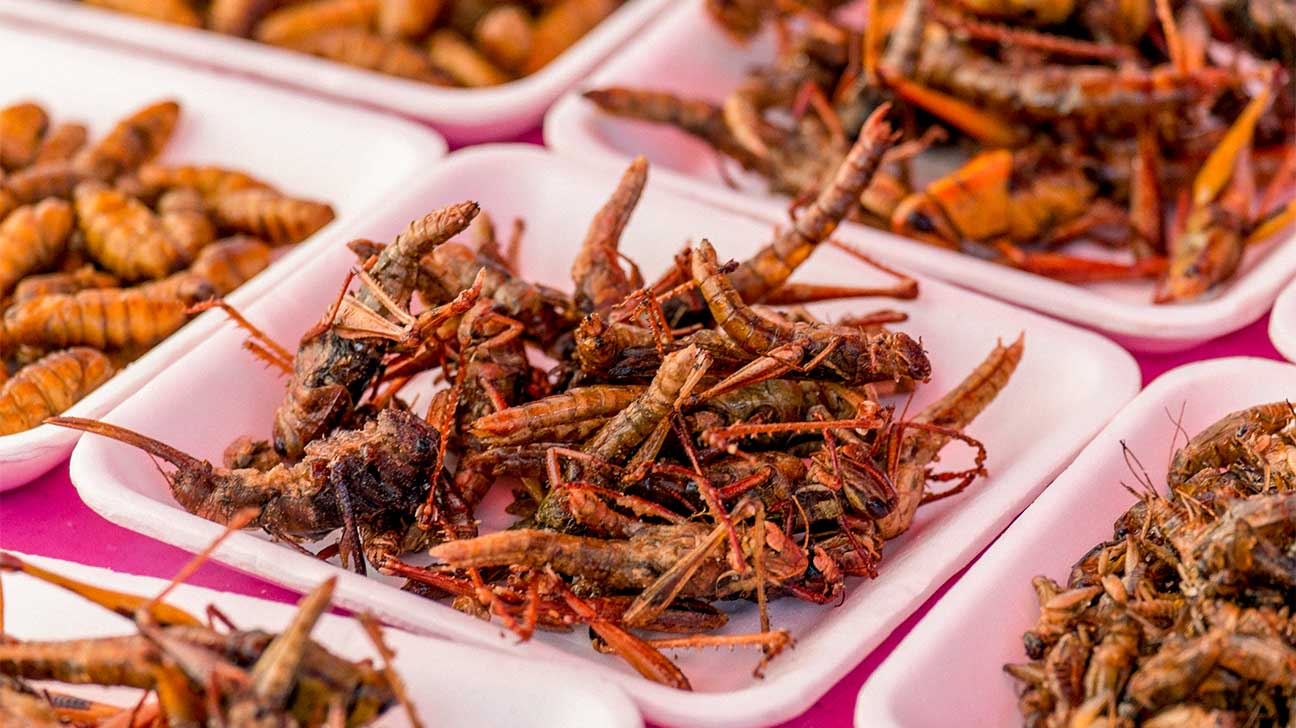By: Jeff Dionot
Edible insects seem to be the next big trend gravitating towards food circles. Crickets, mealworms, fly larvae, and more are now jumping from the dirt and onto plates. While some claim that this new fad will offer a more nutritional alternative, help with climate sustainability, and alleviate malnutrition, many are furrowing their brows at the idea of bugs substituting daily dishes. In this post, we’ll take a look at how adoptable these creepy crawlies truly are.
Tastewise, insects are the most akin to shellfish as both are arthropods. Since the majority of insects are terrestrial rather than aquatic, they have a more earthy taste like mushrooms or root vegetables. Although you can boil, steam, or fry them, the overall taste depends on the type of insect: crickets have an umami flavor like parmesan, scorpion meat has a sort of fishy beef tang, and honeypot ants have a nectarean sweetness. Add in some seasoning and/or sweeteners and you can make your dish even more unique.

If you can make candied bacon, you can certainly make candied arachnids.
Nutritionally, many claim edible insects to have a similar amount of sustenance as found in regular food. Many species contain as much protein as beef, as much iron as spinach, and as much vitamin B12 as salmon (for example, 100 grams of crickets provides 13 grams of protein, 5 grams of healthy fats, and 5 grams of carbohydrates; in comparison, the same amount of cooked beef has double the protein but more than four times the fat). If people don’t wish to see some well-prepared bugs as a main meal, they could view it as an optimal snack, replacing the average high-fructose corn syrup and trans-fat laden munchies entirely.
The biggest macroeconomic reason for eating bugs is the fact that if we were to manufacture them on an industrial scale, they would offer a lower cost and climate-friendly alternative to producing traditional livestock. Economies and ecosystems would be able to conserve more water and produce a lower carbon footprint by starting a small insect farm rather than carving out acres for methane-emitting cattle. On top of that, its efficiency would help easily and quickly provide starving communities with much needed nourishment.
The overarching question is this: should you eat edible insects on a routine basis?
Our answer is no.
While edible bugs have their own reasonable merits, adopting this trend worldwide would go against the entire notion of fine dining. We are born into this land of plenty and now we are expected to subsist on animals with six legs or more? For centuries, large fractions of humanity have survived without resorting entirely to entomophagy (I would define what this word means/use it in a previous sentence to establish the definition) (ex: Europe is home to only 2% of the world’s bug population; this is attributed to its overall size, topography, and history of multiple ice ages) and will continue to do so long after we’re gone. Agriculture was developed roughly 10,000 years ago, and while the majority of civilization took up farming alongside hunter-gathering, insects did not become a major part of everyone’s basic breakfast.
The argument for climate sustainability falls apart when you bring up the demand for other, pre-existing, protein-loaded foods. Too many people, jobs, and diets depend on the production of beef, pork, and chicken. According to Our World In Data, the entire world produced over 300 trillion tons of meat in 2018 with Asia – one of the largest regions that sees eating insects as culturally acceptable – making up over a third of overall production. If people worry too much about the environment, there are other areas and sectors to focus such as emissions of contaminated particles (for example, the WHO claims India, China, the majority of the Middle East, and Africa produce the greatest amounts of pollution levels out of any other country).

Without acknowledging the true culprits of global pollution, everyday people adjusting their diets will not save the world.
In the case of malnutrition, altruists should recognize that population growth could very well be a more pertinent complication. According to Concern Worldwide USA, based on available data, some of the hungriest countries in the world in 2020 include Niger, Mozambique, Somalia, the Democratic Republic of Congo, and Zambia. According to Pew Research, all of the previously listed countries are grouped as countries with population growths of over 200% in 2019 (as % of their current population). On top of this, these countries already dine on bug-based dishes such as kunga cake, a bread-like concoction made with packed midges or flies. The denizens stick to the edible insect tendency yet their native nations contribute little to the world’s eco-based problems.

For every mouth that is fed, one more emerges.
So if itty-bitty beasties are your new craving, go ahead and prepare yourself some ant flambé. But no matter how hard someone signals its benefits, this trend will not be the be all and end all answer to the current intercontinental issues at hand.
• • •
Sources:
https://phys.org/news/2020-07-trend-food-edible-insects.html
https://www.eatcrickster.com/blog/popular-edible-insects
https://junglejims.com/5-reasons-to-start-eating-chocolate-covered-bugs/
https://www.ncbi.nlm.nih.gov/pmc/articles/PMC2373379/
https://borgenproject.org/10-most-malnourished-countries/
https://thecleverroot.com/a-history-of-eating-bugs/#.YBGa_ndKjOQ
https://en.wikipedia.org/wiki/Kunga_cake
https://ourworldindata.org/exports/global-meat-production_v1_850x600.svg
https://www.eatcrickster.com/blog/ultimate-tasting-guide
https://www.concernusa.org/story/worlds-hungriest-countries/

